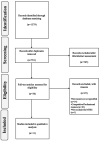Medial Tibial Stress Syndrome in Novice and Recreational Runners: A Systematic Review
- PMID: 33066291
- PMCID: PMC7602098
- DOI: 10.3390/ijerph17207457
Medial Tibial Stress Syndrome in Novice and Recreational Runners: A Systematic Review
Abstract
This systematic review evaluates the existing literature about medial tibial stress syndrome (MTSS) in novice and recreational runners. PubMed/MEDLINE, EMBASE, Web of Science, Scopus, SPORTDiscus and CINAHL databases were searched until July 2020. Studies covering risk factors, diagnostic procedures, treatment methods and time to recovery of MTSS in novice and recreational runners were selected. Eleven studies met the inclusion criteria and were included. The risk factors of MTSS are mainly intrinsic and include higher pelvic tilt in the frontal plane, peak internal rotation of the hip, navicular drop and foot pronation, among others. Computed tomography (CT) and pressure algometry may be valid instruments to corroborate the presence of this injury and confirm the diagnosis. Regarding treatment procedures, arch-support foot orthoses are able to increase contact time, normalize foot pressure distribution and similarly to shockwave therapy, reduce pain. However, it is important to take into account the biases and poor methodological quality of the included studies, more research is needed to confirm these results.
Keywords: navicular drop; overuse injury; running; running-related injuries; shin splints.
Conflict of interest statement
The authors declare no conflict of interest.
Figures
References
Publication types
MeSH terms
LinkOut - more resources
Full Text Sources
Medical
Miscellaneous



